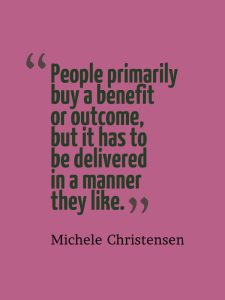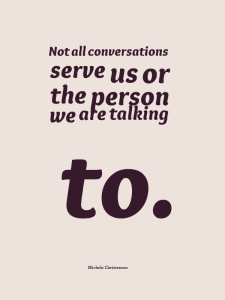 If you’re a sales expert, this will probably be review for you. I’m going through a training right now, and the whole idea of what people actually buy has been covered a lot. I’ve heard a lot of this before, but as with a lot of educational material it sinks in differently the second time around so I have some new ideas.
If you’re a sales expert, this will probably be review for you. I’m going through a training right now, and the whole idea of what people actually buy has been covered a lot. I’ve heard a lot of this before, but as with a lot of educational material it sinks in differently the second time around so I have some new ideas.
Features vs. Benefits
This was a really eye-opening concept to me the first time I heard it, and I continue to deepen my understanding of this idea. Features are facts and data about the product or service, e.g. “This laptop weighs 1 pound.” The benefit would be something like “Light enough to carry around all day without fatigue.” See the difference? I don’t care exactly what it weighs, but I do care that I can carry it around. Here’s another example: “This car has a turning radius that is 20% smaller than other cars in it’s class.” The benefit could be something like “Able to squeeze into tight parking spaces passed over by other cars.” Car stats bore me, but I live in LA so being able to have more parking spaces available is a huge benefit for me.
Delivery
Now that you understand the difference between features and benefits, it’s important to talk about how you deliver those benefits. If your benefit is a reduction in body fat, how do you deliver that result? Is it a one-on-one fitness training program? Is it a food delivery service? A boot camp? A supervised diet? There’s lots of ways to deliver this benefit.
The trap is that it’s easy to talk about delivery and so we tend to focus on that instead of what people will get out of what you are delivering. It’s easy and concrete to talk about 6 sessions, an e-book or a box of printed material. We are also familiar with how we do what we do so it feels comfortable talking about it. It’s also a way to duck out on having to share what results people get from working with you.
A lot of sales experts say that people don’t care at all about how the result is delivered and that they care about the results you can get for them. I agree to some extent with this idea, but I differ in the degree. People do care about how you deliver, just not as much as they care about the results. I think it’s too black-and-white to say they don’t care. Some people hate the telephone, some people don’t want to travel and some people like to read their information. Other people may want premium level one-on-one service.
What people buy
So what do people actually buy?
Primarily it’s the benefit or result, but in order for them to actually buy it has to be delivered in a way they find appealing or at least acceptable. Don’t fall in the trap of talking too much about how you deliver, but don’t ignore delivery either.
What’s the benefit of one of your products or services? How do you deliver that benefit? Tell me about it in the comments.









